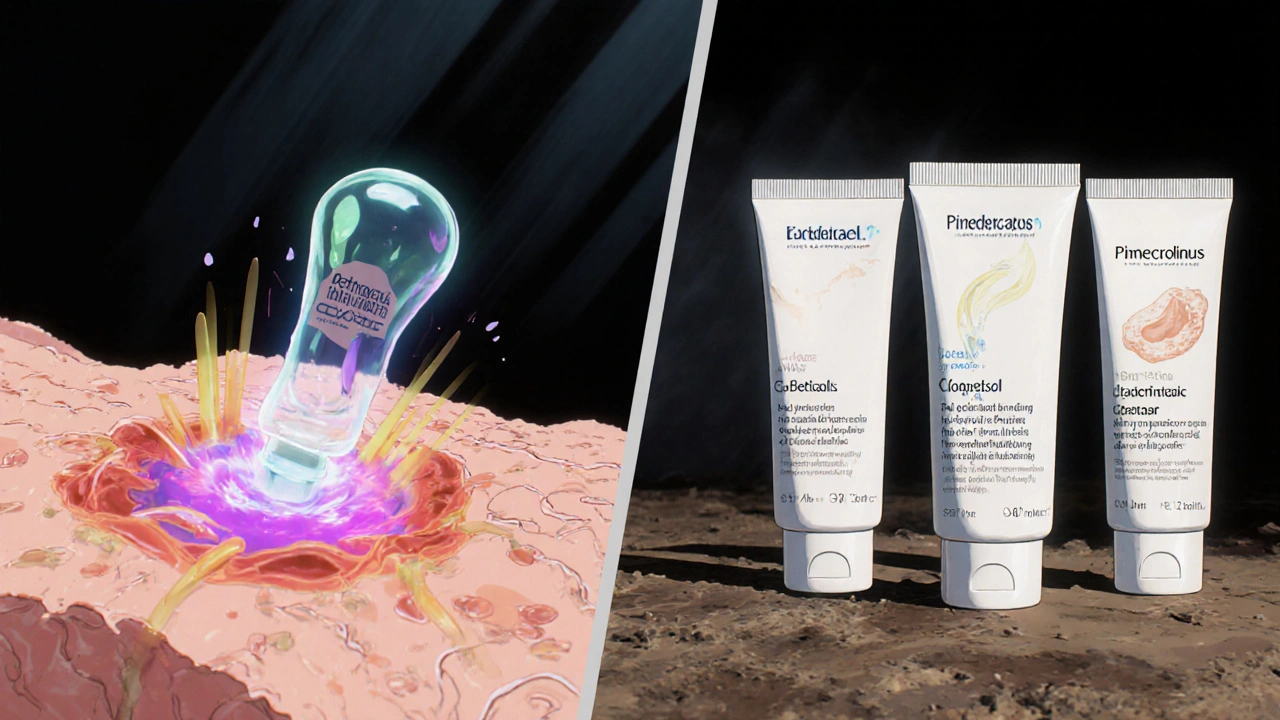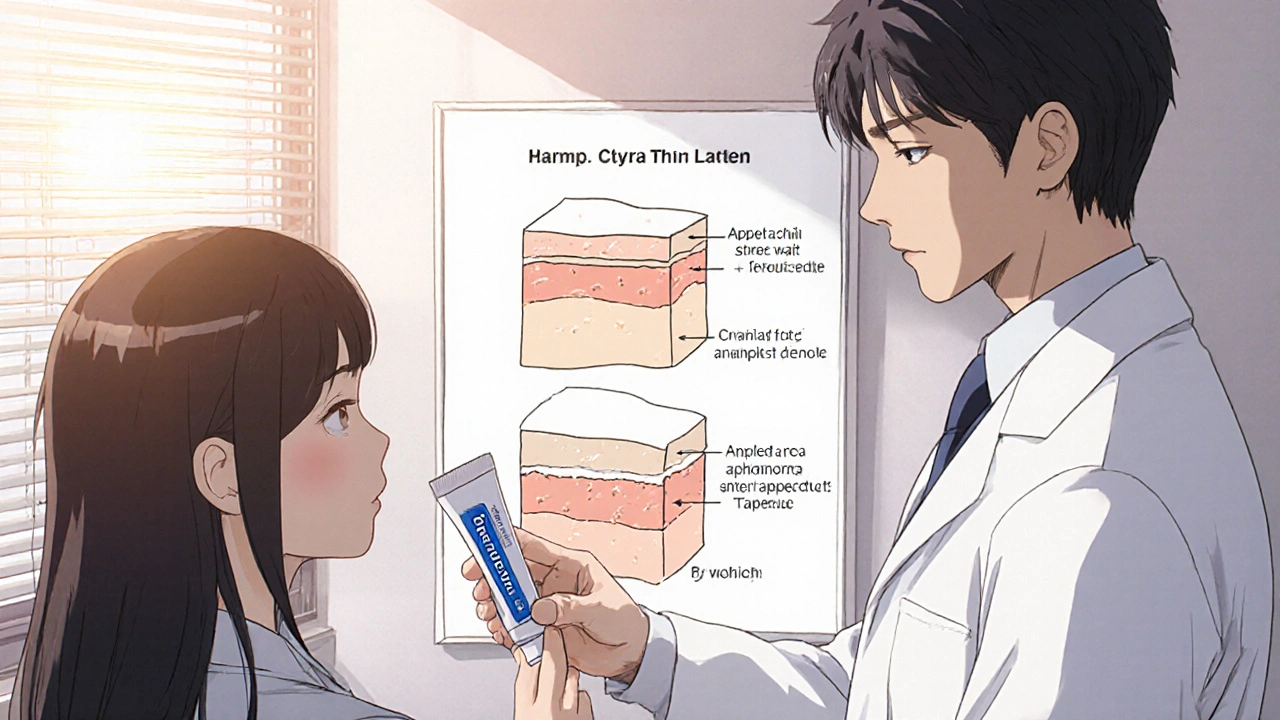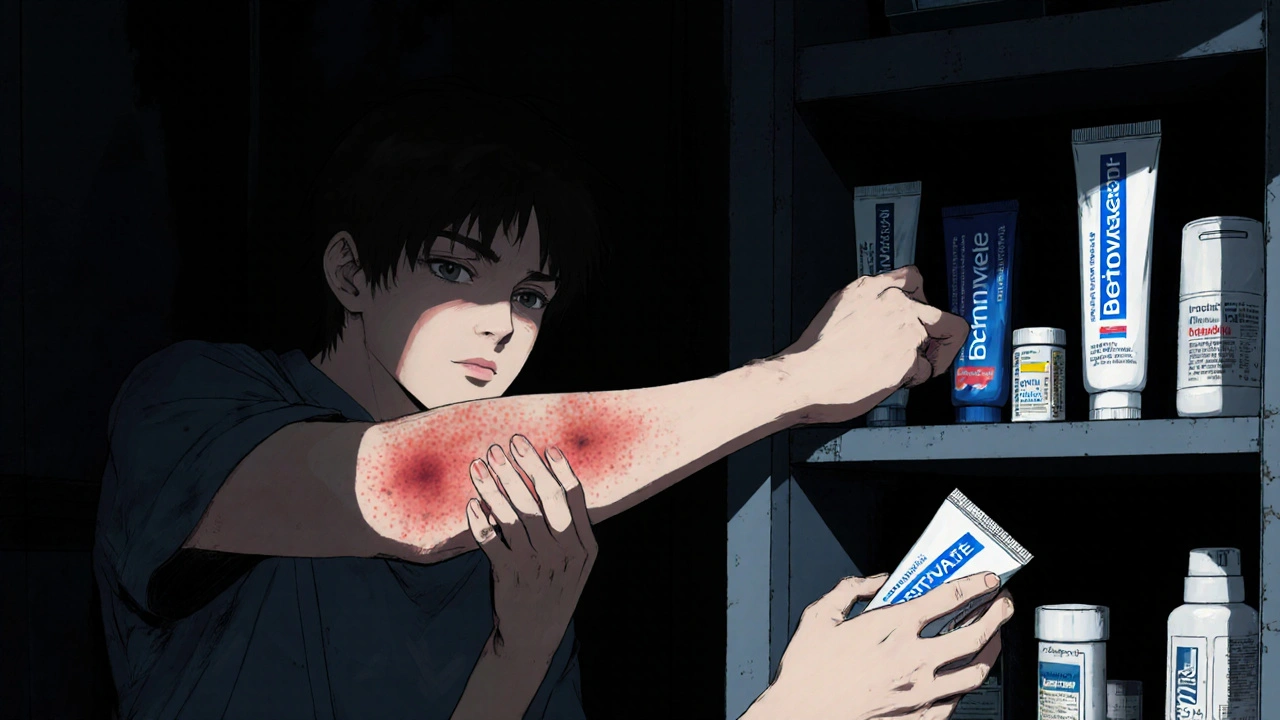If you’ve ever wrestled with an itchy rash or a stubborn flare‑up, you know how tempting it can be to reach for the strongest cream on the shelf. Betnovate is often that go‑to, but is it always the right choice? This guide breaks down Betnovate’s strengths, its drawbacks, and how it stacks up against the most common alternatives, so you can pick the skin‑care weapon that actually fits your needs.
What is Betnovate (Betamethasone)?
Betnovate is a prescription‑only cream that contains betamethasone valerate, a potent synthetic corticosteroid. It belongs to the class of topical corticosteroids and was first approved in the UK in the early 1970s. The drug works by dampening the body’s inflammatory response, which means it can quickly calm redness, swelling, and itching caused by a variety of skin conditions.
How Betnovate Works
Betamethasone binds to glucocorticoid receptors in the skin’s cells. This binding triggers a cascade that suppresses the production of inflammatory mediators like prostaglandins and cytokines. The result is less fluid leakage, reduced immune cell activity, and a noticeable calming of the affected area within hours.
When Doctors Prescribe Betnovate
- Severe eczema (atopic dermatitis) that hasn’t responded to milder creams.
- Psoriasis plaques that need rapid flattening.
- Contact dermatitis with intense redness and itching.
- Hemorrhoidal skin irritation (in some formulations).
Because of its potency, doctors usually limit treatment to short bursts-often 2‑4 weeks-and advise tapering the dose to avoid rebound flare‑ups.

Potential Risks and Side Effects
Like any strong steroid, Betnovate carries a risk profile that matters for long‑term users:
- Skin thinning (atrophy) after prolonged use.
- Stretch marks, especially on thin skin areas.
- Hypopigmentation or hyperpigmentation.
- Rare systemic absorption leading to adrenal suppression.
- Secondary infection if the barrier is compromised.
Because of these concerns, clinicians often ask patients to rotate Betnovate with less potent options.
Alternative Topical Treatments
When you’re weighing Betnovate against other choices, it helps to split the field into two buckets: other corticosteroids of varying strength, and non‑steroidal immunomodulators that act on the same inflammatory pathways without the classic steroid side effects.
Other Corticosteroids
Hydrocortisone is the mildest prescription and over‑the‑counter steroid, usually at 1% strength. It’s ideal for minor irritations and for sensitive areas like the face.
Clobetasol propionate sits at the opposite end of the spectrum. At 0.05% it’s one of the most potent steroids available, reserved for thick‑skinned lesions such as chronic psoriasis.
Mometasone furoate offers a middle ground-stronger than betamethasone valerate in many cases but with a slightly better safety profile for intermittent use.
Non‑Steroidal Immunomodulators
Pimecrolimus (Elidel) blocks calcineurin, a key enzyme in T‑cell activation. It’s approved for mild‑to‑moderate eczema and is a steroid‑free option for facial or intertriginous areas.
Tacrolimus (Protopic) works similarly to pimecrolimus but is a bit stronger, making it suitable for severe atopic dermatitis when steroids are contraindicated.
Both pimecrolimus and tacrolimus can cause a temporary burning sensation on application but avoid the skin‑thinning risk associated with steroids.
Side‑by‑Side Comparison
| Product | Potency | Typical Indications | Prescription Status (UK) | Common Side Effects |
|---|---|---|---|---|
| Betnovate (Betamethasone valerate 0.1%) | High | Eczema, psoriasis, contact dermatitis | Prescription | Skin thinning, stretch marks, pigmentation changes |
| Hydrocortisone 1% | Low | Minor irritations, insect bites | OTC or prescription (higher strengths) | Minimal, mild stinging |
| Clobetasol propionate 0.05% | Very high | Thick psoriasis, chronic lichen planus | Prescription | Severe atrophy, systemic absorption risk |
| Mometasone furoate 0.1% | Medium‑high | Moderate eczema, psoriasis, dermatitis | Prescription | Skin thinning (less than Betnovate), burning |
| Pimecrolimus 1% cream | Non‑steroid (moderate) | Mild‑to‑moderate eczema, facial areas | Prescription | Transient burning, possible infection |
| Tacrolimus 0.1% ointment | Non‑steroid (high) | Severe eczema, steroid‑refractory cases | Prescription | Burning, skin irritation, rare lymphoma concerns |

How to Choose the Right Option
Picking a cream isn’t a one‑size‑fits‑all decision. Consider these four factors:
- Severity of the condition. Mild flare‑ups often respond to hydrocortisone or a calcineurin inhibitor. Severe plaques may need the potency of Betnovate or clobetasol.
- Location on the body. Facial skin is thin; steroids can cause permanent changes. Non‑steroidal options like pimecrolimus shine here.
- Duration of treatment. If you need a long‑term maintenance plan, choose a lower‑potency steroid or a steroid‑free agent to avoid atrophy.
- Patient history. Prior steroid side effects, allergy to ingredients, or systemic conditions (e.g., diabetes) may tilt the balance toward milder or non‑steroidal creams.
Discuss these points with your pharmacist or doctor. Often a short course of Betnovate will bring a rash under control, followed by a switch to a milder steroid or a calcineurin inhibitor for maintenance.
Practical Tips for Safe Use
- Apply a thin layer-more isn’t better.
- Limit use to the affected area; avoid large surface coverage.
- Do not use under occlusive dressings unless instructed.
- Monitor for signs of thinning or discoloration; stop and consult if they appear.
- Store creams at room temperature away from direct sunlight.
Frequently Asked Questions
Can I use Betnovate on my face?
Because the facial skin is thin, doctors usually avoid high‑potency steroids like Betnovate on the face. If a rash is severe, a very short, supervised course may be prescribed, but most clinicians prefer a milder steroid or a calcineurin inhibitor for facial use.
How long is it safe to stay on Betnovate?
Typical courses last 2‑4 weeks. Prolonged use beyond six weeks increases the risk of skin atrophy and systemic absorption. If symptoms linger, talk to your doctor about tapering or switching to a lower‑potency option.
Is Betnovate available over the counter?
No. In the UK Betnovate is classified as a prescription‑only medicine. You’ll need a clinician’s approval before you can get it from a pharmacy.
What’s the difference between Betnovate and Clobetasol?
Both are potent steroids, but clobetasol is considered ultra‑potent and is generally reserved for the toughest, thick‑skinned lesions. Betnovate sits a step below and is often the first‑line strong steroid for eczema or psoriasis.
Are non‑steroidal creams like Pimecrolimus safer long‑term?
They avoid skin thinning, making them a better choice for chronic management, especially on the face or groin. The trade‑off is a possible burning sensation on first use, but most patients find this fades with continued application.


DHARMENDER BHATHAVAR
October 19, 2025 AT 12:58When managing acute dermatitis, a short course of a high‑potency steroid such as Betnovate can quickly suppress inflammation. Transitioning to a milder agent thereafter helps mitigate atrophy risk.
Kevin Sheehan
October 28, 2025 AT 20:58Power in a cream is just a metaphor for control over our own bodies. When a rash erupts, we instinctively reach for the strongest weapon on the shelf. Betnovate, with its potent synthetic corticosteroid, offers that immediate suppression of inflammation. The molecular cascade it triggers-binding glucocorticoid receptors, shutting down prostaglandin synthesis-resembles a tiny rebellion against the immune system. But every rebellion breeds collateral damage, and the skin atrophy seen after prolonged use is the price of that victory. Doctors prescribe it in short bursts precisely because the body remembers the insult and can rebound with a worse flare. If you exceed the two‑to‑four‑week window, the barrier function collapses and you risk systemic absorption. That is why rotating to a lower‑potency steroid or a calcineurin inhibitor is not just smart, it is essential. Hydrocortisone, for example, is gentle enough for everyday irritations and leaves the epidermis largely untouched. Clobetasol sits at the opposite extreme, reserved for thick plaques that have become almost impenetrable. Mometasone offers a middle ground, delivering high efficacy while moderating the atrophic risk. Non‑steroidal options like pimecrolimus or tacrolimus bypass the steroid pathway entirely, avoiding the thinning dilemma. They do cause a burning sensation at first, but that sensation fades as the immune modulation takes hold. From a philosophical standpoint, the choice between a steroid and a calcineurin inhibitor mirrors the decision between force and finesse. Force conquers quickly but can leave scars; finesse may take longer but preserves the terrain. Thus, the optimal regimen is a choreography: a brief, powerful Betnovate strike to quell the storm, followed by a sustained, gentle maintenance phase.
Jay Kay
November 7, 2025 AT 05:58Betnovate sounds like a superhero, but steroids always have a kryptonite.
Rakhi Kasana
November 16, 2025 AT 14:58The metaphor of force versus finesse captures the clinical reality well. In practice, the initial aggressive suppression must be balanced with a downstream strategy to preserve skin integrity.
Monika Bozkurt
November 25, 2025 AT 23:58From a pharmacokinetic perspective, the transient systemic exposure of betamethasone valerate is negligible when applied intermittently, yet cumulative dermal absorption can become salient in compromised barrier states. Consequently, a tapering schedule post‑acute phase is advocated to attenuate hypothalamic‑pituitary‑adrenal axis feedback loops.
Penny Reeves
December 5, 2025 AT 08:58Honestly, the whole debate feels like an academic exercise when most patients just need relief. Betnovate delivers that relief, but the marketing hype around “non‑steroidal” alternatives often glosses over their cost and the initial burn. If you can afford a decent calcineurin inhibitor, it’s a worthy trade‑off; otherwise, a disciplined short course of Betnovate remains perfectly sensible.
Bobby Marie
December 14, 2025 AT 17:58True, cost is a real barrier and insurance formularies don’t always play nice.